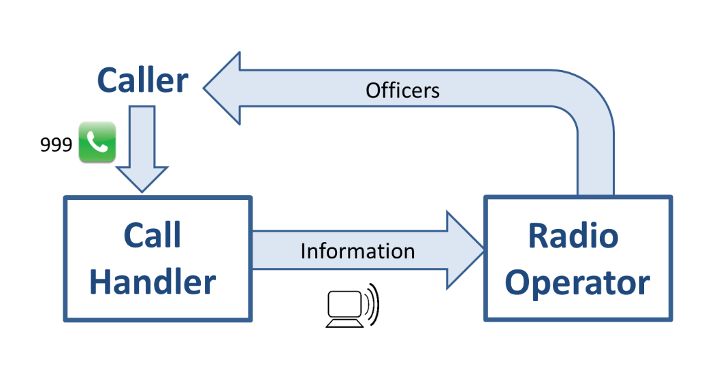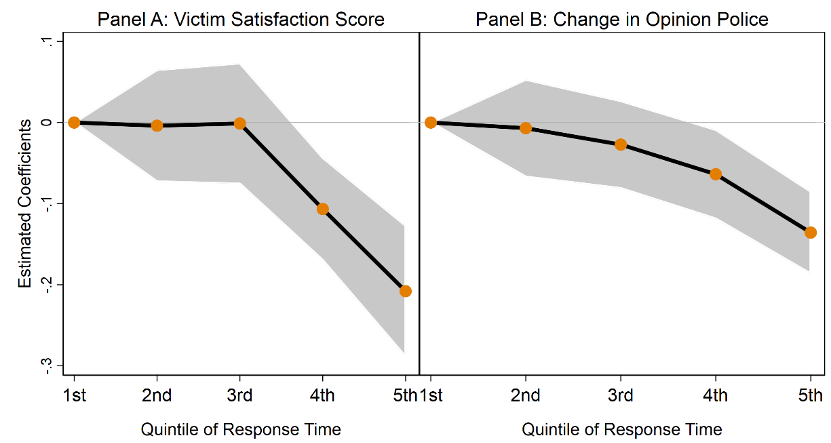Summary
The COVID-19 pandemic has meant that many of us have now been working at home for most of the last year. The results of this global experiment have sometimes been positive, or at least not as negative as feared. Engagement and productivity have not nosedived, and many workers seem to prefer the new arrangements. There are, however, potential drawbacks. Not interacting with colleagues in person on a regular basis may, for example, decrease the sort of creativity that is facilitated by physical proximity, provide fewer learning opportunities for junior workers, and threaten performance on activities that require rapid decisions on the basis of complex information.
Many factors have changed for workers over the last year, however, which makes it difficult to use the pandemic to isolate the effects of working from home. We exploit a natural experiment in the Greater Manchester Police to study how workers use face-to-face communication to do their job faster.
In our setting, call handlers and radio operators work together to handle emergency calls, but have (at least partially) different objectives—handles want to minimize the time calls spend in a queue, while operators want to minimise total incident response time. For exogenous reasons, between 2009 and 2012 operators would sometimes be in the same room, and sometimes be in different parts of Manchester. This enables us to study the benefits of co-location in a high-pressure and high-stakes environment.
Our baseline finding is that, on average, an operator’s response time is 2% lower when the handler and the operator are located in the same room. This effect varies across the response time distribution, however, with a 10% lower response time for very urgent incidents, and an approximately zero effect for routine incidents. We also find, however, that this benefit has a time cost; handlers located in the same room take 2.5% more time to become available for their next call.
Next, we analysed how the benefits of face-to-face interaction varied with the characteristics of the workers, teams and environment. First, we found that incentives matter. Co-location does not decrease response time when the handler is in the month of their performance review. Second, we found that co-location response times are lower for handler-operator pair with similar demographic characteristics or more frequent past interactions. Finally, the benefits of being in the same room fall relatively quickly as the distance between desks increases.
Public finances have come under increasing pressure in the last decade. In 2012, all operators moved to two rooms, all handlers to a third room, and the fourth room was decommissioned and sold. Our findings suggest that these costs savings had an impact on performance; the inability to communicate in person had a detrimental effect on response time, especially for incidents classified as violent crimes. Although this study takes place in just one setting, many workplaces involve the transmission of a similar type of complex information across co-workers. We would there expect the type of patterns that we have identified here to also arise in other environments.
Main article
Many factors have changed over the last year, which makes it difficult to use the pandemic to study the costs and benefits of working from home. However, a natural experiment around the handling of incoming calls by the Greater Manchester Police indicates that co-location can improve aspects of worker performance, though at a cost. In this case, the co-location of the two employees responsible for responding to incidents is associated with a 2% lower response time, but the initial call handler takes 2.5% more time to get to their next call. The study also suggests that the effect of co-location varies with task type, incentive strength, social connections, and office size.
The international response to the COVID-19 pandemic has emphasised working from home, especially for office workers tasked with the generation and processing of information. Compliance has generally been very high, with most companies not just encouraging, but mandating, their employees to work from home. This has led to an emptying of city centres and financial districts, and has implied that many white-collar workers have not met their colleagues in person for more than a year.
A natural experiment in the Greater Manchester Police indicates that co-location can improve worker performance on high-pressure tasks
The results of this global experiment on the organisation of production have been positive, or at least not as negative as feared. Managers have found that engagement and productivity have not nosedived, and that workers often prefer the new arrangements (The Economist, 2021). This is confirmed by Bloom et al. (2015), which finds that workers in a Chinese call centre experienced increases in both performance and job satisfaction when randomly selected to work from home. It is widely believed that the old status quo will not come back when the pandemic is over, and that workers will demand to—and will be allowed to—work remotely, at least part of the time.
The potential drawbacks of working from home
There are, however, potential drawbacks in not interacting with one’s colleagues in person on a regular basis. First, workers in the year 2020 inherited a legacy of connections, social capital and expertise that was the result of investments during the pre-pandemic years, and it seems that productivity has broadly held up. It is less clear, however, whether these investments can be replicated remotely. This is particularly worrisome in innovating or creative industries, in which unplanned face-to-face interactions—which are facilitated by physical proximity—often provide the spark for new ideas (Catalini, 2018).
A recent study finds co-location of workers decreased the time police took to response to incoming emergency calls by 2%
The second potential drawback predominantly affects junior workers, who may strongly benefit from personal interactions with their more experienced colleagues. To the extent that pre-scheduled Zoom meetings cannot effectively substitute for these interactions, cohorts of new recruits may experience setbacks in their human capital trajectories.
Lastly, there are activities in which all workers benefit from the informal help of their colleagues, especially those activities that require rapid decisions on the basis of complex information. In those settings, being able to draw upon the information of other co-workers can make a big difference.
A natural experiment circumvents endogeneity issues around the study of working from home
Studying the benefits of face-to-face communication is not straightforward. Following the same firms before and after the pandemic will be misleading because many things changed in 2020. Comparing those organisations that encouraged working from home prior to the pandemic to those that did not also be misleading; these corporate decisions are endogenous to their expected impact. Bloom et al. (2015) evaluates a field experiment and credibly estimates causal effects, but they focus on a completely individual task in which the potential for mutual help is limited.
We exploit a natural experiment in the Operational Communications Branch (OCB) of the Greater Manchester Police (GMP) to study how workers take advantage of the ability to communicate face-to-face in order to help each other do their jobs faster. In our setting, 999 calls are connected through to the OCB, and each call is dealt with sequentially by two workers (see Figure 1). The handler answers the call, gathers the details and describes the incident in the internal computer system. The radio operator then reads the description and allocates a police officer on the basis of incident characteristics and officer availability.
Figure 1: Operational Communications Branch

Although they work together, handler and operator have (at least partially) different objectives. Operators are responsible for minimising the response time of their incidents (i.e., the time between receiving the handler’s report and the arrival of the officer). Handlers’ main objective is to minimise the time that incoming calls spend waiting in the call queue, so they are expected to be ready to take new calls as soon as they have finished inputting the details of the previous call.
A major barrier to the quick allocation of an officer is that the electronic log written by the handler needs to be processed and understood by the operator, which takes time. Given this obstacle, the ability to engage face-to-face with the handler who wrote the log can potentially decrease response time.
Responding quickly to incidents is a major objective of the police, both because it contributes to solving crimes (Blanes i Vidal and Kirchmaier, 2018) and because it increases public satisfaction (see Figure 2). Our work setting is therefore a high-pressure and high-stakes environment, not dissimilar to air traffic control or the rooms in which teams of CIA officers track the location of Jason Bourne (The Bourne Identity, 2002).
Figure 2: Correlation between Response Time and Victim Satisfaction

Our natural experiment takes advantage of the fact that, between November 2009 and January 2012, OCB staff were spread across four buildings or ‘rooms’. Each room contained the operators that oversaw a different part of Manchester, and the rooms were located in the areas they oversaw (see Figure 3). Handlers were also dispersed across the four locations, but they received 999 calls on the basis of a first-come-first-serve queueing system. This meant that, for exogenous reasons, operators would sometimes be reading the descriptions of incidents created by same-room handlers, while on other occasions the handlers were based in a different part of Manchester.
Figure 3: Location and Radio Operations Coverage of OCB Rooms

Findings suggest that co-location can have significant benefits, though these come at a cost
Our first baseline finding is that operators benefit from the ability to receive help from the handler creating the incident: response time is 2% lower when the handler and the operator are located in the same room. An important qualifier is that the 2% average decrease in response time is not a constant effect throughout the response time distribution. Quantile regressions show that very urgent incidents benefit the most (i.e., around 10%), while routine incidents are associated with a zero effect.
Cost savings in the Greater Manchester Police decreased worker co-location, which may have increased incident response times
We also find, however, that this benefit is not a ‘free lunch’, as it involves a (time) cost by the handler providing the help: handlers located in the same room take 2.5% more time to become available to take their next incoming 999 call.
Incentives, social connections, and size of office affect the benefits of co-location
Our study comes from a setting in which we can understand and measure very precisely every stage of the production process. This is in the tradition of ‘insider econometrics’ (Shaw, 2009), but it obviously has the limitation that we are studying a single working environment. We can, however, analyse how the benefits of interacting face-to-face vary, within our setting, with the characteristics of the workers, teams and environment.
Our first finding here is that incentives matter, even within this public sector setting with generally low-powered incentives. Specifically, we study handlers that are in the month of their performance review. Because handlers are not nominally responsible for response time, we would expect that handlers with slightly sharper (career) incentives are less willing to provide help, and this is indeed what we find. Co-location does not decrease response time (and it does not increase the time that handlers take to be ready to take new calls) when the handler is about to be evaluated by their supervisor. We find similar effects when comparing handlers who have (and have not) been upgraded to the top pay band. These findings suggest that providing very sharp incentives for workers to focus on their own productivity can be detrimental to the communication flows through which mutual assistance is provided among co-workers.
Our second finding is that social connections between workers are a strong predictor of the benefits of co-location. Specifically, we find that response time decreases more under co-location when handler and operator are of the same gender, closer in age, and have worked together more often in the past. A corollary of this finding is the existence of complementarities: social proximity allows workers to reap the benefit of geographical proximity, either because they are more willing to help each other or because face-to-face communication is more effective in homogenous teams.
New research suggests that working from home may decrease performance on tasks that require rapid decision-making on the basis of complex information
Lastly, we are able to evaluate how face-to-face communication varies with geographical distance even when handler and operator are working in the same room. We can measure the distance between the desks from which workers operate, and the practice of ‘hot-desking’ means that we can compare the same pair of workers on days on which their desks are closer together or further apart. We find that the benefits of being in the same room depreciate relatively quickly: sitting on opposite sides of a room is equivalent to working in different areas of Manchester. This finding suggests that there is a limit to how large working environments can be, while still benefitting from the advantages of face-to-face interactions.
Policy implications
Public finances have come under increasing pressure in the last decade. While the current Conservative government is nominally in favour of higher police resources, police forces are likely to be operating under tight budgets for the foreseeable future. The OCB was reorganised in 2012, such that all operators moved to two rooms, all handlers to a third room, and the fourth room was decommissioned and sold. While this reorganisation may have been efficient from a budgetary perspective, our findings suggest that the inability to communicate in person had a detrimental effect on response time, especially for incidents classified as violent crimes. Handler and operator pairs that used to work in the same room had, on average, an 8% higher response time for violent crimes in 2012 than they had had in 2011.
Needless to say, our setting does not allow us to speak to the benefits of face-to-face communication that arise from higher creativity, the transmission of human capital, and other issues arising in many working environments. Nevertheless, many team settings involve the transmission of a similar type of complex information across co-workers, as well as the trade-off between the benefits for the receiver the communication and the time cost for the sender. We would there expect the type of pattern that we have identified to also arise in other environments.
This article summarizes ‘Face-to-Face Communication in Organizations’ by Diego Battiston, Jordi Blanes i Vidal, and Tom Kirchmaier, published in The Review of Economic Studies in October 2020.
Diego Battiston is at the University of Edinburgh and the London School of Economics. Jordi Blanes i Vidal is at the London School of Economics. Tom Kirchmaier is at the Copenhagen Business School and the London School of Economics.






